Spatial Assessment of Community Resilience from 2012 Hurricane Sandy Using Nighttime Light
Abstract
:1. Introduction
2. Study Area and Data
2.1. Study Area
2.2. NASA Black Marble Products
2.3. Auxiliary Data
3. Analysis
3.1. Conceptual Framework of Recovery Trajectories
3.2. NTL Image Selection and Processing
3.3. Spatial Analysis
3.4. Regression Analysis
4. Results
4.1. Temporal Changes of NTL Radiance
4.2. Spatial Patterns of NTL Change
4.3. Univariate Regression Results
5. Discussion
5.1. Interpretation of NTL Spatial Pattern
5.2. Utility of the Black Marble Product in Disaster Monitoring
5.3. Future Work
6. Conclusions
Author Contributions
Funding
Institutional Review Board Statement
Informed Consent Statement
Data Availability Statement
Conflicts of Interest
References
- Adger, W.N. Social and ecological resilience: Are they related? Prog. Hum. Geogr. 2000, 24, 347–364. [Google Scholar] [CrossRef]
- Cai, H.; Lam, N.S.; Qiang, Y.; Zou, L.; Correll, R.M.; Mihunov, V. A synthesis of disaster resilience measurement methods and indices. Int. J. Disaster Risk Reduct. 2018, 31, 844–855. [Google Scholar] [CrossRef]
- Harte, E.W.; Childs, I.R.; Hastings, P.A. Imizamo Yethu: A Case Study of Community Resilience to Fire Hazard in an Informal Settlement Cape Town, South Africa. Geogr. Res. 2009, 47, 142–154. [Google Scholar] [CrossRef]
- Salvia, R.; Quaranta, G. Place-Based Rural Development and Resilience: A Lesson from a Small Community. Sustainability 2017, 9, 889. [Google Scholar] [CrossRef] [Green Version]
- Pfefferbaum, R.L.; Pfefferbaum, B.; Van Horn, R.L.; Klomp, R.W.; Norris, F.H.; Reissman, D.B. The communities advancing resilience toolkit (CART): An intervention to build community resilience to disasters. J. Public Health Manag. Pract. 2013, 19, 250–258. [Google Scholar] [CrossRef] [PubMed]
- Cutter, S.L.; Boruff, B.J.; Shirley, W.L. Social Vulnerability to Environmental Hazards. Soc. Sci. Q. 2003, 84, 242–261. [Google Scholar] [CrossRef]
- Cutter, S.L.; Burton, C.G.; Emrich, C.T. Disaster Resilience Indicators for Benchmarking Baseline Conditions. J. Homel. Secur. Emerg. Manag. 2010, 7, 51. [Google Scholar] [CrossRef]
- Peacock, W.G.; Brody, S.D.; Seitz, W.A.; Merrell, W.J.; Vedlitz, A.; Zahran, S.; Stickney, R. Advancing Resilience of Coastal Localities: Developing, Implementing, and Sustaining the Use of Coastal Resilience Indicators: A Final Report; Hazard Reduction and Recovery Center, Texas A&M University: College Station, TX, USA, 2010; pp. 1–148. [Google Scholar]
- Flanagan, B.E.; Gregory, E.W.; Hallisey, E.J.; Heitgerd, J.L.; Lewis, B. A Social Vulnerability Index for Disaster Management. J. Homel. Secur. Emerg. Manag. 2011, 8, 3. [Google Scholar] [CrossRef]
- Anderson, C.C.; Hagenlocher, M.; Renaud, F.G.; Sebesvari, Z.; Cutter, S.L.; Emrich, C.T. Comparing index-based vulnerability assessments in the Mississippi Delta: Implications of contrasting theories, indicators, and aggregation methodologies. Int. J. Disaster Risk Reduct. 2019, 39, 101128. [Google Scholar] [CrossRef] [Green Version]
- Cutter, S.L. The landscape of disaster resilience indicators in the USA. Nat. Hazards 2016, 80, 741–758. [Google Scholar] [CrossRef]
- Burton, C.G. A Validation of Metrics for Community Resilience to Natural Hazards and Disasters Using the Recovery from Hurricane Katrina as a Case Study. Ann. Assoc. Am. Geogr. 2015, 105, 67–86. [Google Scholar] [CrossRef]
- Alahmadi, M.; Mansour, S.; Martin, D.; Atkinson, P.M. An Improved Index for Urban Population Distribution Mapping Based on Nighttime Lights (DMSP-OLS) Data: An Experiment in Riyadh Province, Saudi Arabia. Remote Sens. 2021, 13, 1171. [Google Scholar] [CrossRef]
- Chen, X.; Nordhaus, W.D. Using luminosity data as a proxy for economic statistics. Proc. Natl. Acad. Sci. USA 2011, 108, 8589–8594. [Google Scholar] [CrossRef] [PubMed] [Green Version]
- Li, X.; Ge, L.; Chen, X. Detecting Zimbabwe’s Decadal Economic Decline Using Nighttime Light Imagery. Remote Sens. 2013, 5, 4551–4570. [Google Scholar] [CrossRef] [Green Version]
- Mohan, P.; Strobl, E. The short-term economic impact of tropical Cyclone Pam: An analysis using VIIRS nightlight satellite imagery. Int. J. Remote Sens. 2017, 38, 5992–6006. [Google Scholar] [CrossRef]
- Stevens, M.R.; Berke, P.R.; Song, Y. Creating disaster-resilient communities: Evaluating the promise and performance of new urbanism. Landsc. Urban Plan. 2010, 94, 105–115. [Google Scholar] [CrossRef]
- Long, F.; Zheng, L.; Song, Z. High-speed rail and urban expansion: An empirical study using a time series of nighttime light satellite data in China. J. Transp. Geogr. 2018, 72, 106–118. [Google Scholar] [CrossRef]
- Xie, Y.; Weng, Q. World energy consumption pattern as revealed by DMSP-OLS nighttime light imagery. GISci. Remote Sens. 2016, 53, 265–282. [Google Scholar] [CrossRef]
- Levin, N. The impact of seasonal changes on observed nighttime brightness from 2014 to 2015 monthly VIIRS DNB composites. Remote Sens. Environ. 2017, 193, 150–164. [Google Scholar] [CrossRef]
- Zhao, X.; Yu, B.; Liu, Y.; Yao, S.; Lian, T.; Chen, L.; Yang, C.; Chen, Z.; Wu, J. NPP-VIIRS DNB Daily Data in Natural Disaster Assessment: Evidence from Selected Case Studies. Remote Sens. 2018, 10, 1526. [Google Scholar] [CrossRef] [Green Version]
- Gillespie, T.W.; Frankenberg, E.; Chum, K.F.; Thomas, D. Night-time lights time series of tsunami damage, recovery, and economic metrics in Sumatra, Indonesia. Remote Sens. Lett. 2014, 5, 286–294. [Google Scholar] [CrossRef] [PubMed] [Green Version]
- Kohiyama, M.; Hayashi, H.; Maki, N.; Higashida, M.; Kroehl, H.W.; Elvidge, C.D.; Hobson, V.R. Early damaged area estimation system using DMSP-OLS night-time imagery. Int. J. Remote Sens. 2004, 25, 2015–2036. [Google Scholar] [CrossRef]
- Fan, X.; Nie, G.; Deng, Y.; An, J.; Zhou, J.; Li, H. Rapid detection of earthquake damage areas using VIIRS nearly constant contrast night-time light data. Int. J. Remote Sens. 2018, 40, 2386–2409. [Google Scholar] [CrossRef]
- Román, M.O.; Stokes, E.C.; Shrestha, R.; Wang, Z.; Schultz, L.; Carlo, E.A.S.; Sun, Q.; Bell, J.; Molthan, A.; Kalb, V.; et al. Satellite-based assessment of electricity restoration efforts in Puerto Rico after Hurricane Maria. PLoS ONE 2019, 14, e0218883. [Google Scholar] [CrossRef]
- Hultquist, C.; Simpson, M.; Cervone, G.; Huang, Q. Using nightlight remote sensing imagery and Twitter data to study power outages. In Proceedings of the 1st ACM SIGSPATIAL International Workshop on the Use of GIS in Emergency Management, Bellevue, WA, USA, 3–6 November 2015; ACM Press: Cambridge, MA, USA, 2015; pp. 1–6. [Google Scholar]
- Wang, Z.; Román, M.O.; Sun, Q.; Molthan, A.L.; Schultz, L.A.; Kalb, V.L. Monitoring disaster-related power outages using NASA black marble nighttime light product. ISPRS Int. Arch. Photogramm. Remote Sens. Spat. Inf. Sci. 2018, XLII-3, 1853–1856. [Google Scholar] [CrossRef] [Green Version]
- Wang, L.; Fan, H.; Wang, Y. An estimation of housing vacancy rate using NPP-VIIRS night-time light data and OpenStreetMap data. Int. J. Remote Sens. 2019, 40, 8566–8588. [Google Scholar] [CrossRef]
- Hou, J.; Ren, Z.; Wang, P.; Wang, J.; Gao, Y. Tsunami Assessment and Evacuation Analysis Using Remote Sensing for Tianya District of Sanya City, China. J. Earthq. Tsunami 2019, 13, 1941003. [Google Scholar] [CrossRef]
- Elvidge, C.D.; Baugh, K.E.; Zhizhin, M.; Hsu, F.-C. Why VIIRS data are superior to DMSP for mapping nighttime lights. Proc. Asia-Pac. Adv. Netw. 2013, 35, 62. [Google Scholar] [CrossRef] [Green Version]
- Forbes, D.J. Multi-scale analysis of the relationship between economic statistics and DMSP-OLS night light images. GISci. Remote Sens. 2013, 50, 483–499. [Google Scholar] [CrossRef]
- Román, M.O.; Wang, Z.; Sun, Q.; Kalb, V.; Miller, S.D.; Molthan, A.; Schultz, L.; Bell, J.; Stokes, E.C.; Pandey, B.; et al. NASA’s Black Marble nighttime lights product suite. Remote Sens. Environ. 2018, 210, 113–143. [Google Scholar] [CrossRef]
- Cao, C.; Shao, X.; Uprety, S. Detecting Light Outages After Severe Storms Using the S-NPP/VIIRS Day/Night Band Radiances. IEEE Geosci. Remote Sens. Lett. 2013, 10, 1582–1586. [Google Scholar] [CrossRef]
- Diakakis, M.; Deligiannakis, G.; Katsetsiadou, K.; Lekkas, E. Hurricane Sandy mortality in the Caribbean and continental North America. Disaster Prev. Manag. 2015, 24, 132–148. [Google Scholar] [CrossRef]
- Vickery, P.J.; Skerlj, P.F.; Lin, J.; Twisdale, L.A., Jr.; Young, M.A.; Lavelle, F.M. HAZUS-MH hurricane model methodology. II: Damage and loss estimation. Nat. Hazards Rev. 2006, 7, 94–103. [Google Scholar] [CrossRef] [Green Version]
- Bureau, U.S.C. (2016, December 7). Core-Based Statistical Areas. The United States Census Bureau. Available online: https://www.census.gov/topics/housing/housing-patterns/about/core-based-statistical-areas.html (accessed on 1 June 2021).
- The Website Services & Coordination Staff, U.S.C.B. (1994, March 1). Largest Urbanized Areas with Selected Cities and Metro Areas. U.S. Census. Available online: https://www.census.gov/dataviz/visualizations/026/ (accessed on 1 June 2021).
- Román, M.O.; Wang, Z.; Shrestha, R.; Yao, T.; Kalb, V. Black Marble User Guide Version 1.0; NASA: Washington, DC, USA, 2019.
- Blake, E.S.; Kimberlain, T.B.; Berg, R.J.; Cangialosi, J.P.; Beven, J.L. Tropical Cyclone Report: Hurricane Sandy; National Hurricane Center: Miami, FL, USA, 2013; Volume 12, pp. 1–10. [Google Scholar]
- United States. Department of Housing and Urban Development. (2013). Hurricane Sandy Damage Estimates by Block Group, 2012. [Shapefile]. United States. Department of Housing and Urban Development. Available online: https://earthworks.stanford.edu/catalog/stanford-jp095bg5089 (accessed on 1 June 2021).
- Vicino, T.J.; Hanlon, B.; Short, J.R. Megalopolis 50 Years On: The Transformation of a City Region. Int. J. Urban Reg. Res. 2007, 31, 344–367. [Google Scholar] [CrossRef]
- Multi-Resolution Land Characteristics (MRLC) Consortium. Available online: http://www.mrlc.gov (accessed on 26 May 2019).
- Homer, C.; Dewitz, J.; Jin, S.; Xian, G.; Costello, C.; Danielson, P.; Gass, L.; Funk, M.; Wickham, J.; Stehman, S.; et al. Conterminous United States land cover change patterns 2001–2016 from the 2016 National Land Cover Database. ISPRS J. Photogramm. Remote Sens. 2020, 162, 184–199. [Google Scholar] [CrossRef]
- Jin, S.; Homer, C.; Yang, L.; Danielson, P.; Dewitz, J.; Li, C.; Zhu, Z.; Xian, G.; Howard, D. Overall Methodology Design for the United States National Land Cover Database 2016 Products. Remote Sens. 2019, 11, 2971. [Google Scholar] [CrossRef] [Green Version]
- Wickham, J.D.; Stehman, S.V.; Gass, L.; Dewitz, J.; Fry, J.A.; Wade, T.G. Accuracy assessment of NLCD 2006 land cover and impervious surface. Remote Sens. Environ. 2013, 130, 294–304. [Google Scholar] [CrossRef]
- Xian, G.; Homer, C.; Dewitz, J.; Fry, J.; Hossain, N.; Wickham, J. The change of impervious surface area between 2001 and 2006 in the conterminous United States. Photogramm. Eng. Remote Sens. 2011, 77, 758–762. [Google Scholar]
- Yang, L.; Huang, C.; Homer, C.G.; Wylie, B.; Coan, M.J. An approach for mapping large-area impervious surfaces: Synergistic use of Landsat-7 ETM+ and high spatial resolution imagery. Can. J. Remote Sens. 2003, 29, 230–240. [Google Scholar] [CrossRef]
- Qiang, Y.; Huang, Q.; Xu, J. Observing community resilience from space: Using nighttime lights to model economic disturbance and recovery pattern in natural disaster. Sustain. Cities Soc. 2020, 57, 102115. [Google Scholar] [CrossRef]
- Bruneau, M.; Chang, S.E.; Eguchi, R.T.; Lee, G.C.; O’Rourke, T.D.; Reinhorn, A.M.; Shinozuka, M.; Tierney, K.; Wallace, W.A.; Von Winterfeldt, D. A Framework to Quantitatively Assess and Enhance the Seismic Resilience of Communities. Earthq. Spectra 2003, 19, 733–752. [Google Scholar] [CrossRef] [Green Version]
- Koliou, M.; van de Lindt, J.W.; McAllister, T.P.; Ellingwood, B.R.; Dillard, M.; Cutler, H. State of the research in community resilience: Progress and challenges. Sustain. Resilient Infrastruct. 2020, 5, 131–151. [Google Scholar] [CrossRef]
- Qiang, Y.; Xu, J. Empirical assessment of road network resilience in natural hazards using crowdsourced traffic data. Int. J. Geogr. Inf. Sci. 2020, 34, 2434–2450. [Google Scholar] [CrossRef]
- Vugrin, E.D.; Turnquist, M.A.; Brown, N.J. Optimal recovery sequencing for enhanced resilience and service restoration in transportation networks. Int. J. Crit. Infrastruct. 2014, 10, 218–246. [Google Scholar] [CrossRef] [Green Version]
- White, R.K.; Edwards, W.C.; Farrar, A.; Plodinec, M.J. A Practical Approach to Building Resilience in America’s Communities. Am. Behav. Sci. 2014, 59, 200–219. [Google Scholar] [CrossRef]
- Zou, L.; Lam, N.S.N.; Cai, H.; Qiang, Y. Mining Twitter Data for Improved Understanding of Disaster Resilience. Ann. Am. Assoc. Geogr. 2018, 108, 1422–1441. [Google Scholar] [CrossRef]
- Hutto, C.; Gilbert, E. Vader: A parsimonious rule-based model for sentiment analysis of social media text. In Proceedings of the International AAAI Conference on Web and Social Media, Ann Arbor, MI, USA, 1–4 June 2014; Volume 8. [Google Scholar]
- Ribeiro, F.N.; Araújo, M.; Gonçalves, P.; Gonçalves, M.A.; Benevenuto, F. SentiBench—A benchmark comparison of state-of-the-practice sentiment analysis methods. EPJ Data Sci. 2016, 5, 1. [Google Scholar] [CrossRef] [Green Version]
- Shelton, T.; Poorthuis, A.; Graham, M.; Zook, M. Mapping the data shadows of Hurricane Sandy: Uncovering the sociospatial dimensions of ‘big data’. Geoforum 2014, 52, 167–179. [Google Scholar] [CrossRef]
- Xu, J.; Qiang, Y. Analysing Information Diffusion in Natural Hazards using Retweets—A Case Study of 2018 Winter Storm Diego. Ann. GIS 2021, 1–15. [Google Scholar] [CrossRef]
- Cohen, J. A power primer. Psychol. Bull. 1992, 112, 155–159. [Google Scholar] [CrossRef]
- Rappaport, E.N. Loss of Life in the United States Associated with Recent Atlantic Tropical Cyclones. Bull. Am. Meteorol. Soc. 2000, 81, 2065–2073. [Google Scholar] [CrossRef] [Green Version]
- Schmidlin, T.W. Human fatalities from wind-related tree failures in the United States, 1995–2007. Nat. Hazards 2008, 50, 13–25. [Google Scholar] [CrossRef]
- Yeo, S.W.; Blong, R.J. Fiji’s worst natural disaster: The 1931 hurricane and flood. Disasters 2010, 34, 657–683. [Google Scholar] [CrossRef]
- Brown, S.; Parton, H.; Driver, C.; Norman, C. Evacuation During Hurricane Sandy: Data from a Rapid Community Assessment. PLoS Curr. 2016, 8. [Google Scholar] [CrossRef] [PubMed] [Green Version]
- Li, J.; Ozbay, K.; Bartin, B. Effects of Hurricanes Irene and Sandy in New Jersey: Traffic patterns and highway disruptions during evacuations. Nat. Hazards 2015, 78, 2081–2107. [Google Scholar] [CrossRef]
- Wang, Q.; Taylor, J.E. Quantifying Human Mobility Perturbation and Resilience in Hurricane Sandy. PLoS ONE 2014, 9, e112608. [Google Scholar] [CrossRef]
- Zou, L.; Lam, N.S.N.; Shams, S.; Cai, H.; Meyer, M.A.; Yang, S.; Lee, K.; Park, S.-J.; Reams, M.A. Social and geographical disparities in Twitter use during Hurricane Harvey. Int. J. Digit. Earth 2019, 12, 1300–1318. [Google Scholar] [CrossRef]
- Mihunov, V.V.; Lam, N.S.N.; Zou, L.; Wang, Z.; Wang, K. Use of Twitter in disaster rescue: Lessons learned from Hurricane Harvey. Int. J. Digit. Earth 2020, 13, 1454–1466. [Google Scholar] [CrossRef]
- Sagara, E. (2012, November 18). Hurricane Sandy’s Destruction: Aerial Assessment Shows Nearly 72K Buildings Damaged IN N.J. Available online: https://www.nj.com/news/2012/11/hurricane_sandys_destruction_a.html (accessed on 1 June 2021).
- Sandalow, D. Hurricane Sandy and Our Energy Infrastructure; US Department of Energy: Washington, DC, USA, 2012.
- Burger, J.; Gochfeld, M. Perceptions of personal and governmental actions to improve responses to disasters such as SuperstormSandy. Environ. Hazards 2014, 13, 200–210. [Google Scholar] [CrossRef]
- Shaw, S.-L.; Tsou, M.-H.; Ye, X. Editorial: Human dynamics in the mobile and big data era. Int. J. Geogr. Inf. Sci. 2016, 30, 1687–1693. [Google Scholar] [CrossRef]
- Pongponrat, K.; Ishii, K. Social vulnerability of marginalized people in times of disaster: Case of Thai women in Japan Tsunami 2011. Int. J. Disaster Risk Reduct. 2018, 27, 133–141. [Google Scholar] [CrossRef]
- Farquhar, S.; Dobson, N. Community and university participation in disaster-relief recovery: An example from eastern North Carolina. J. Community Pract. 2004, 12, 203–217. [Google Scholar] [CrossRef]
- Zhao, N.; Zhang, W.; Liu, Y.; Samson, E.L.; Chen, Y.; Cao, G. Improving Nighttime Light Imagery With Location-Based Social Media Data. IEEE Trans. Geosci. Remote Sens. 2018, 57, 2161–2172. [Google Scholar] [CrossRef]
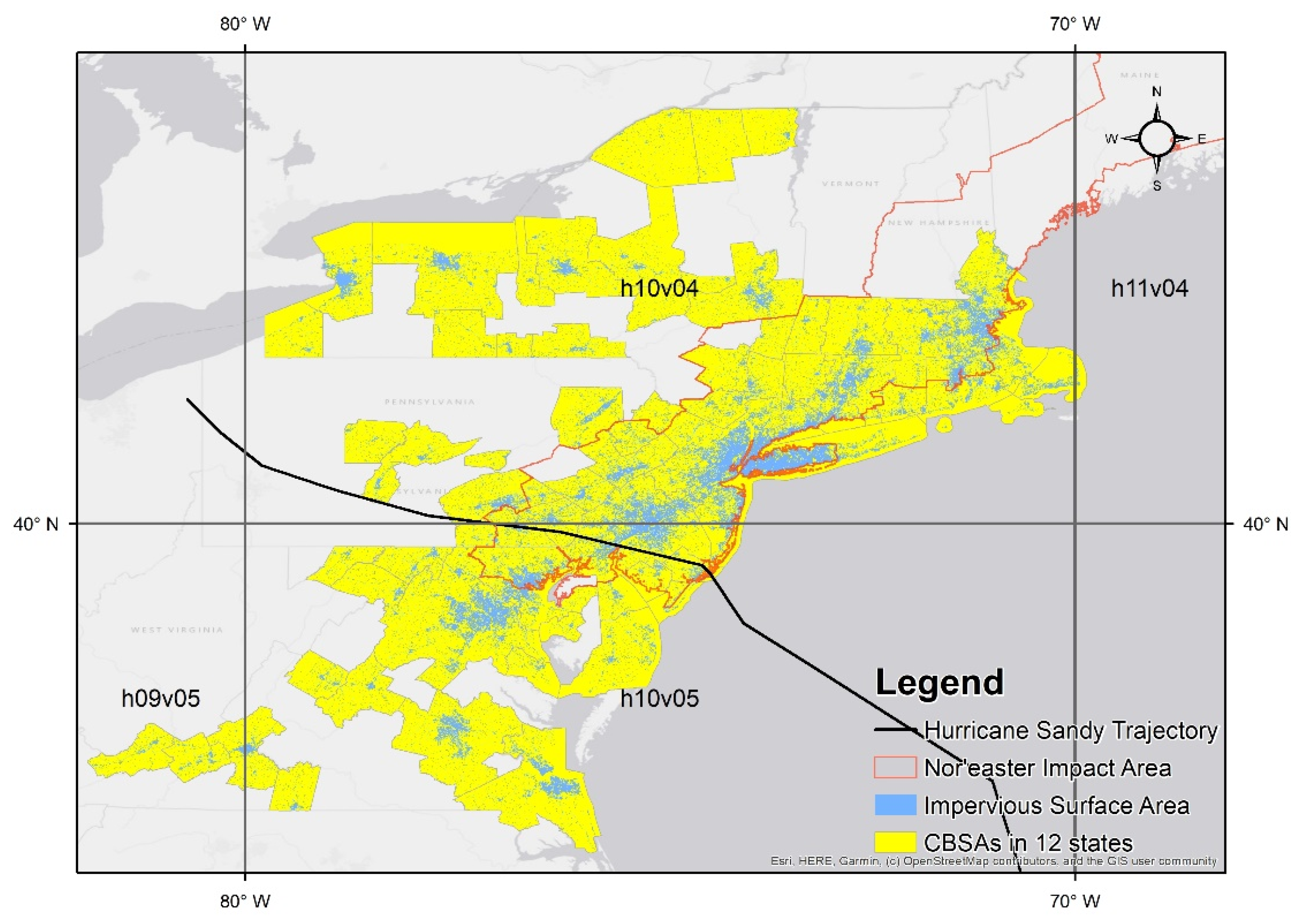
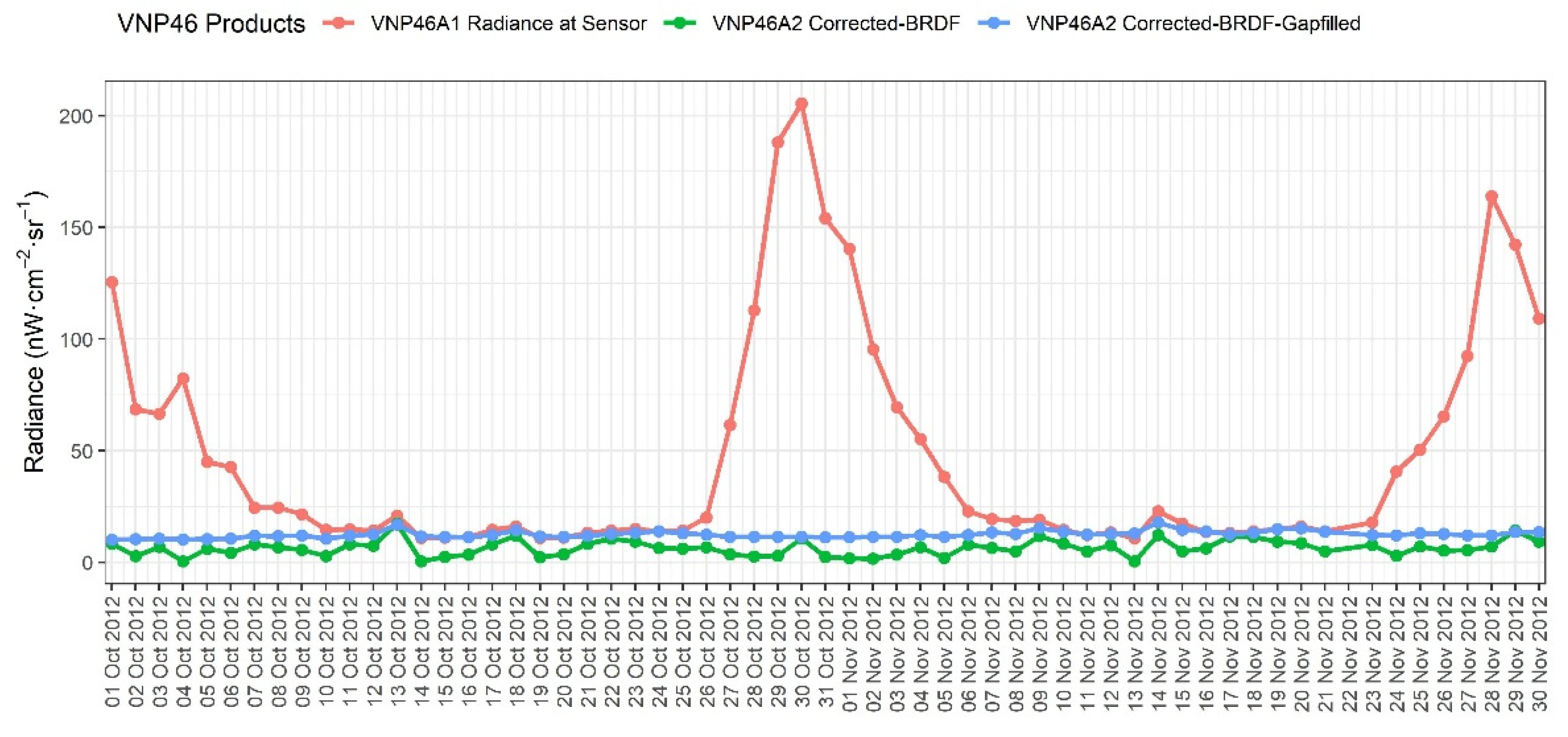
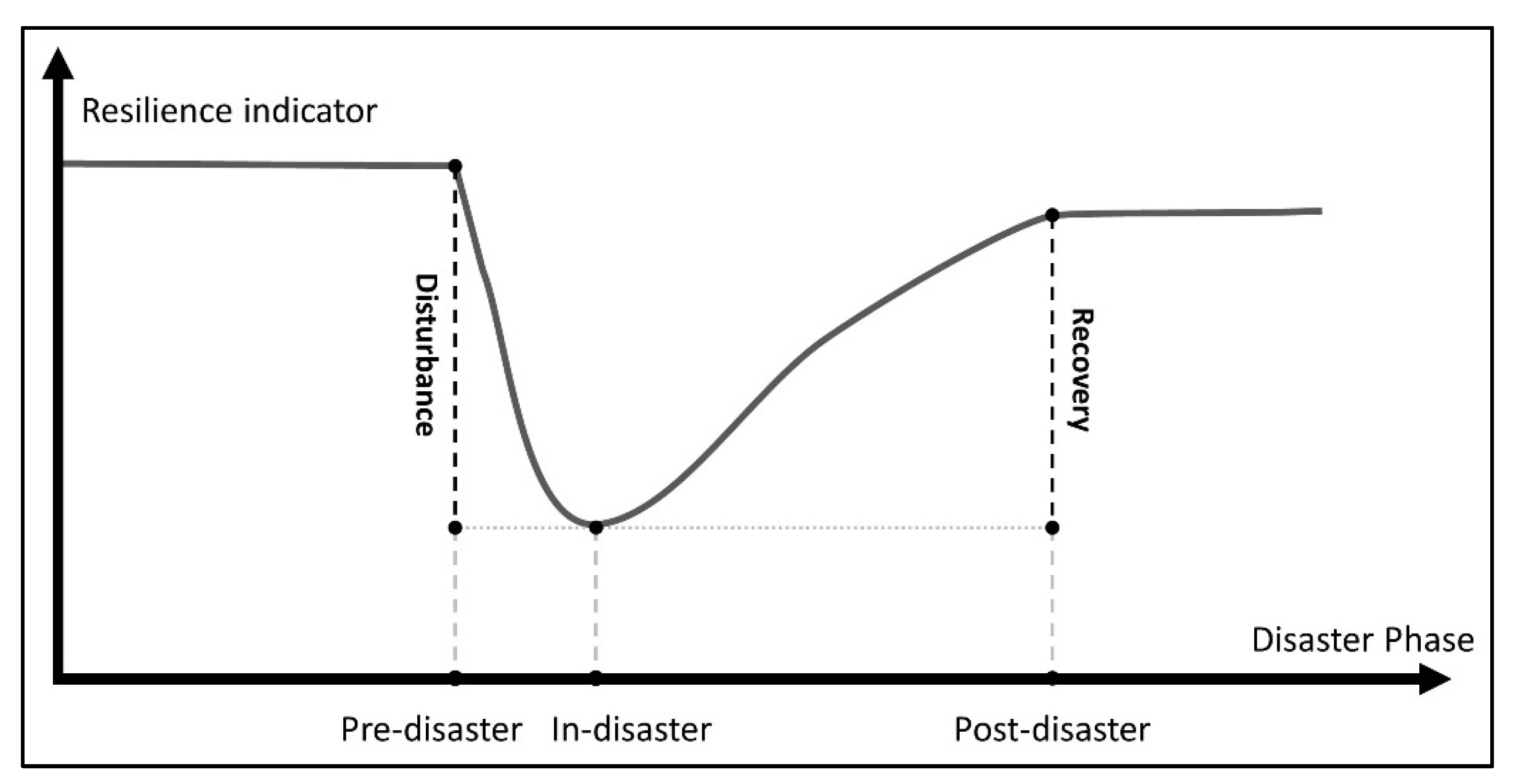
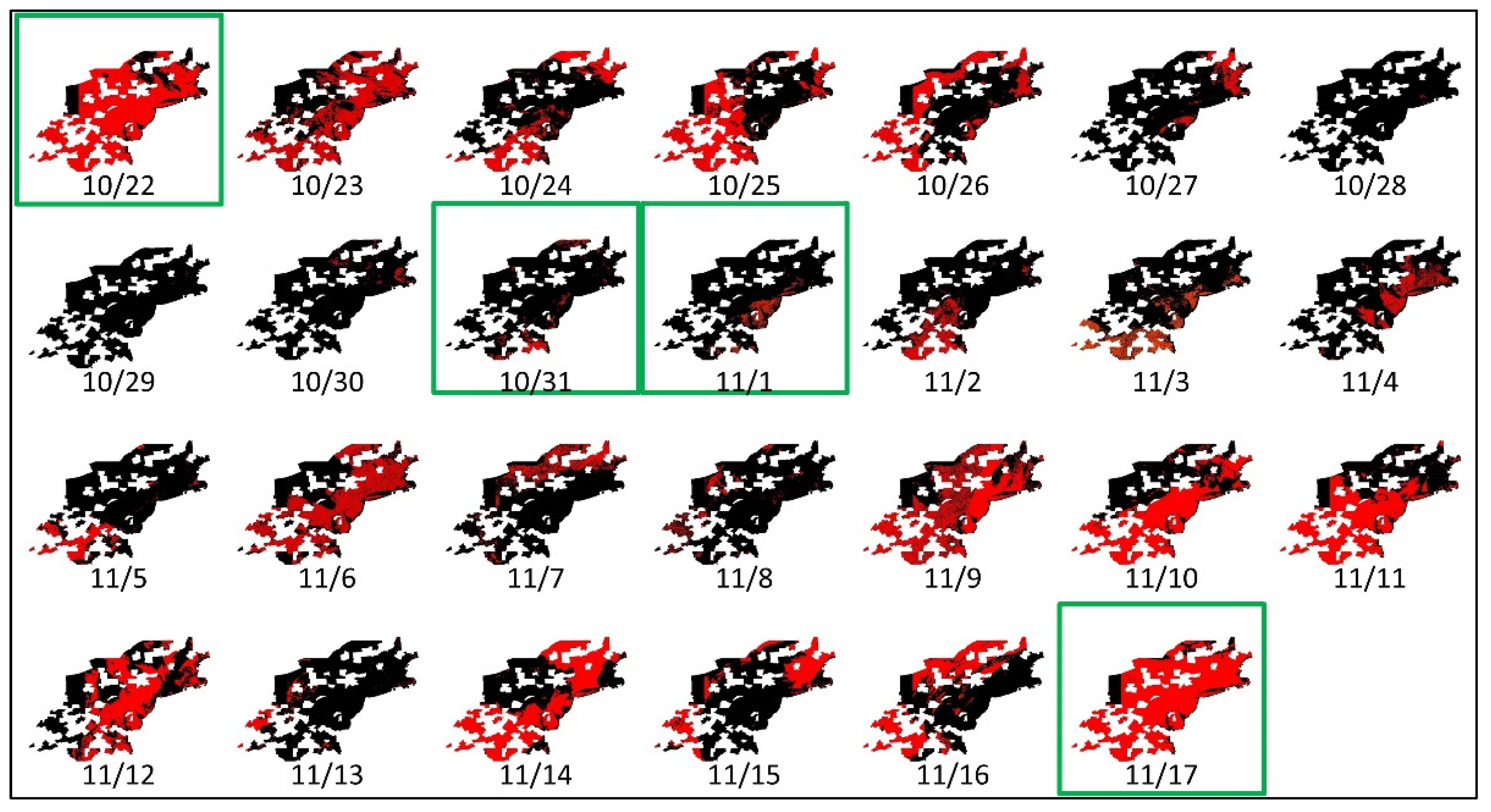
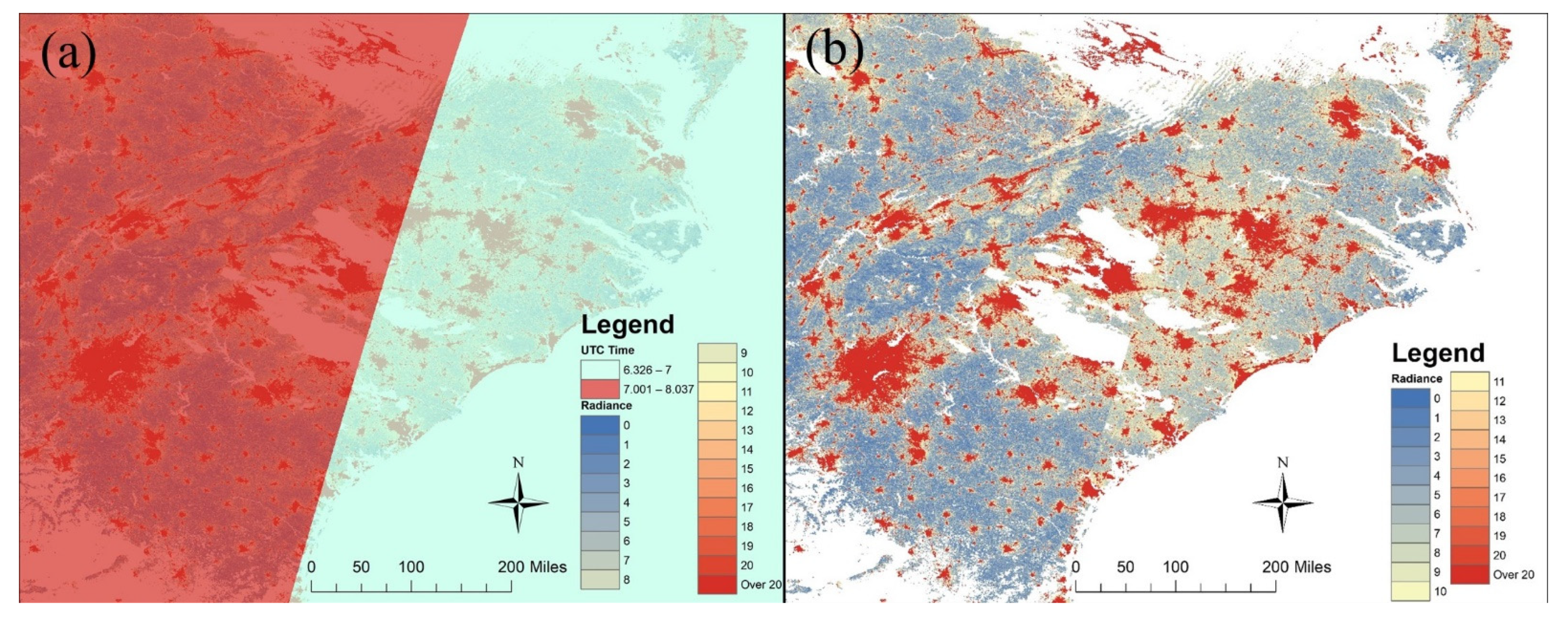
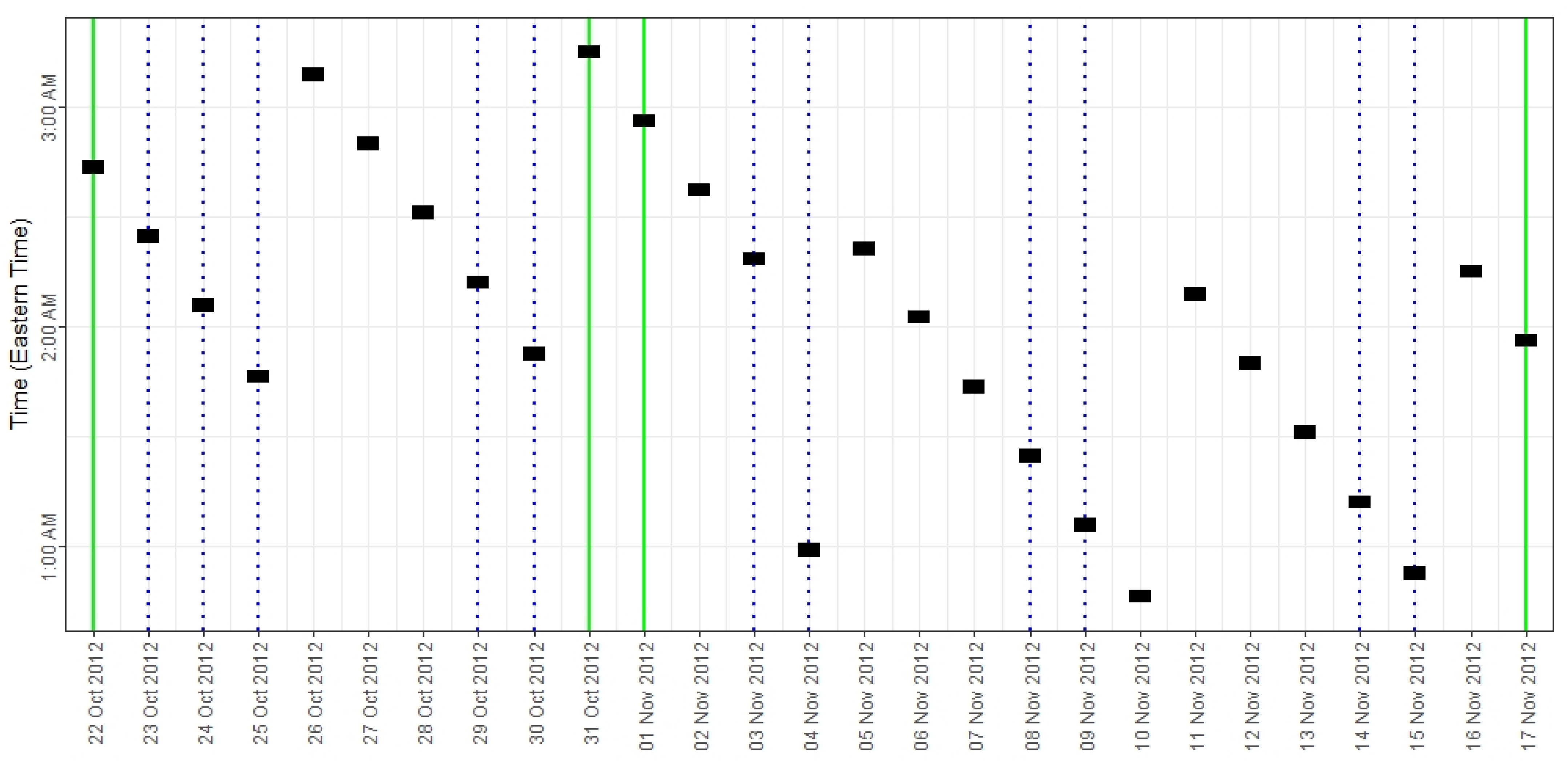
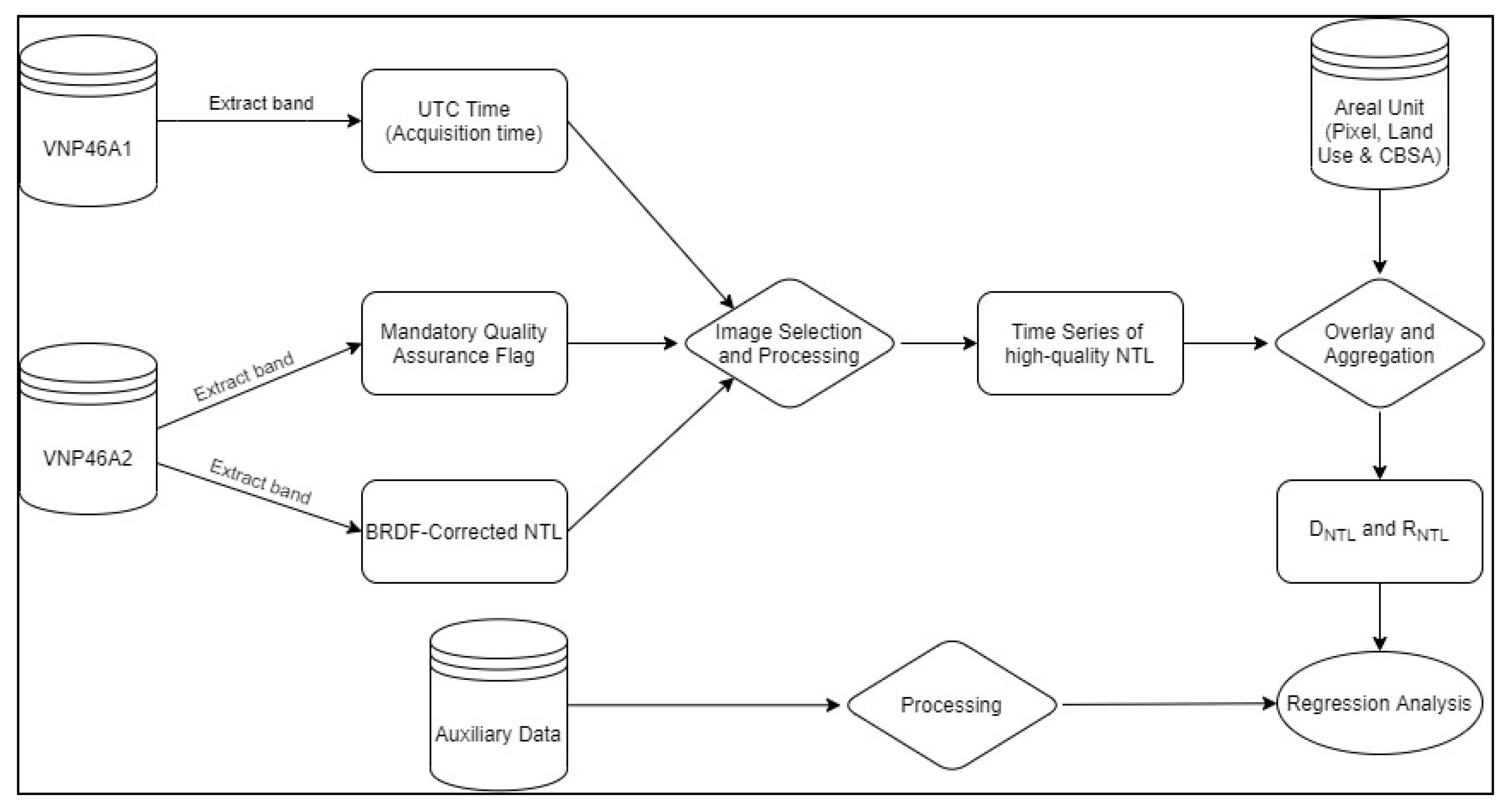
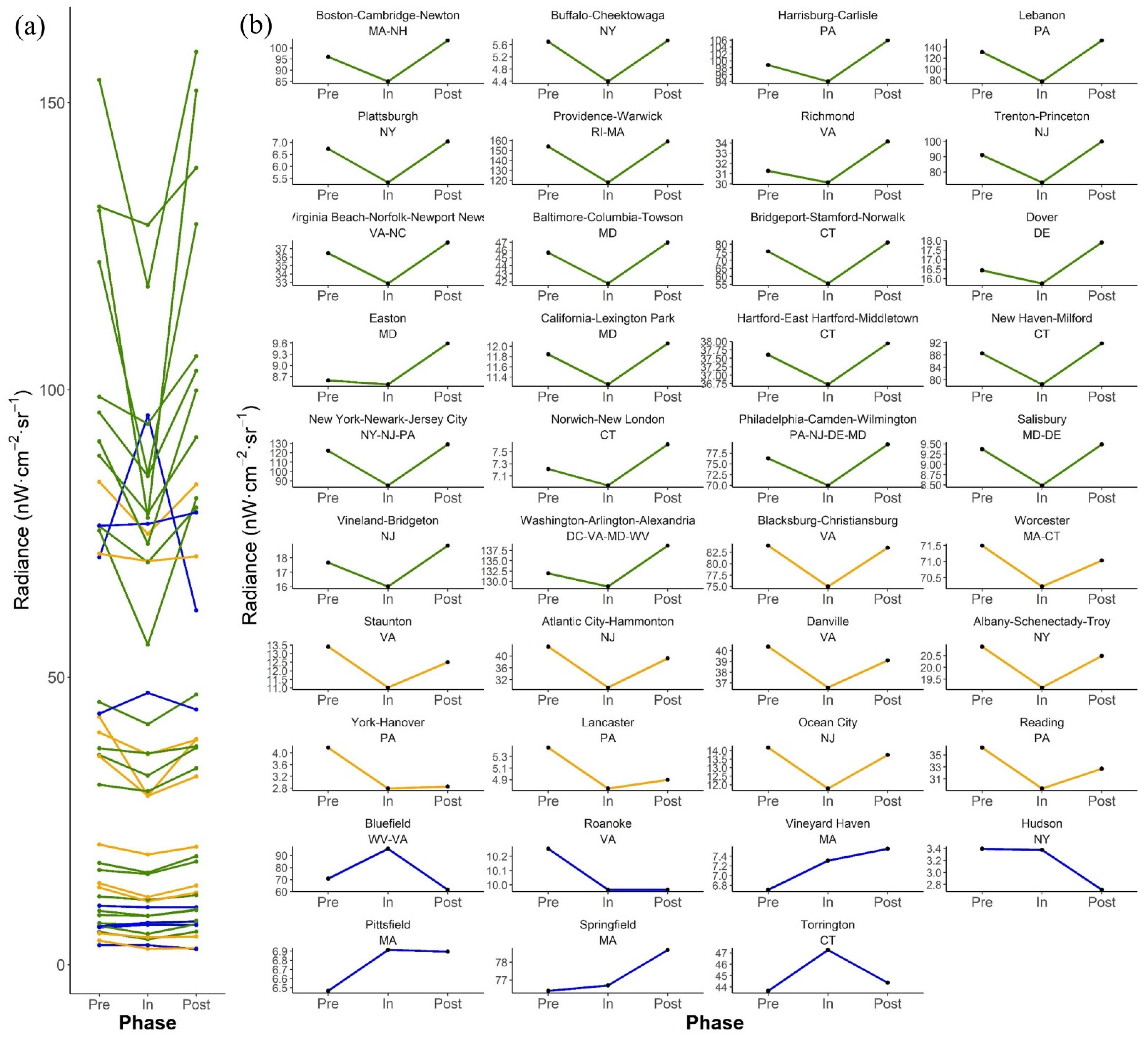
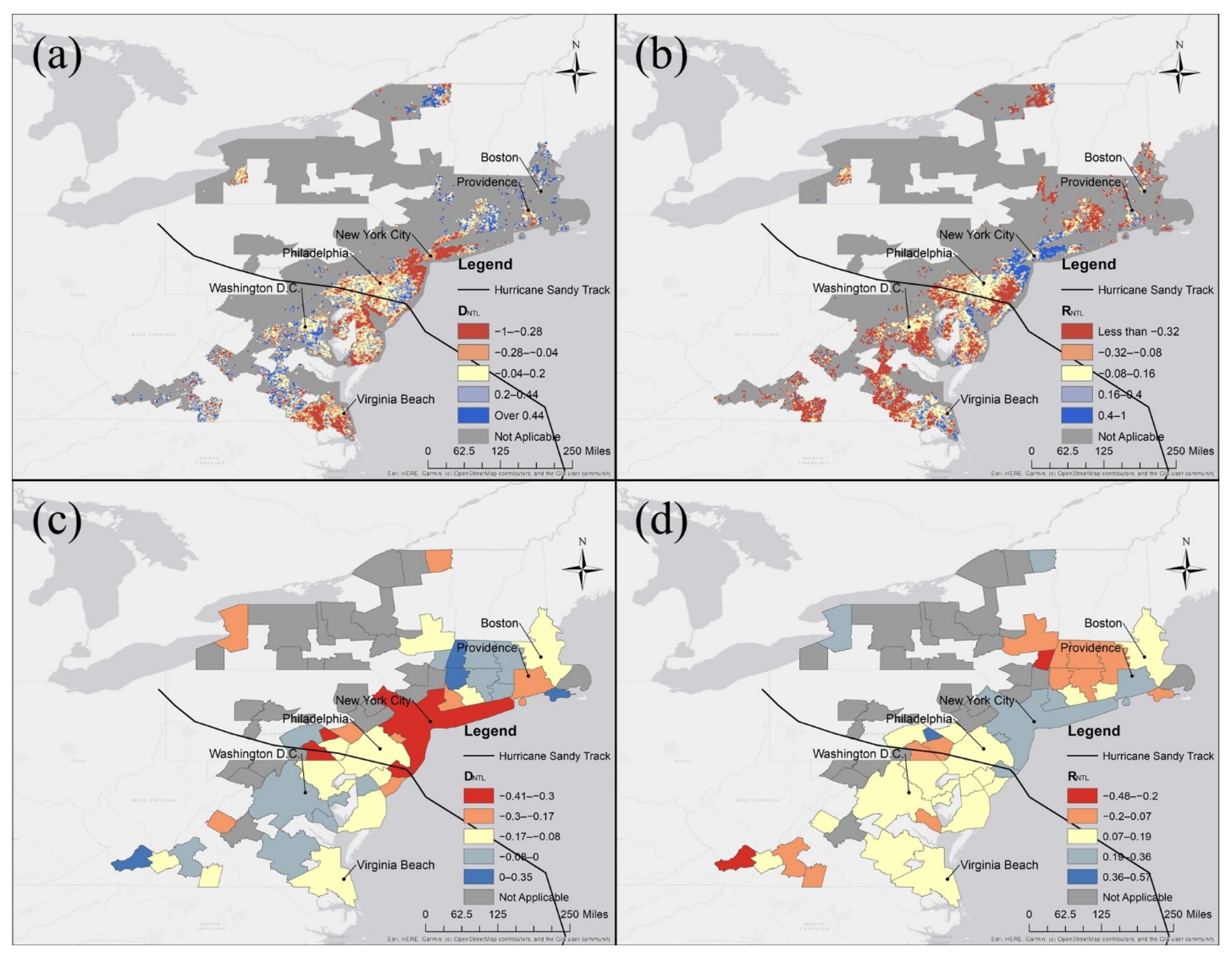
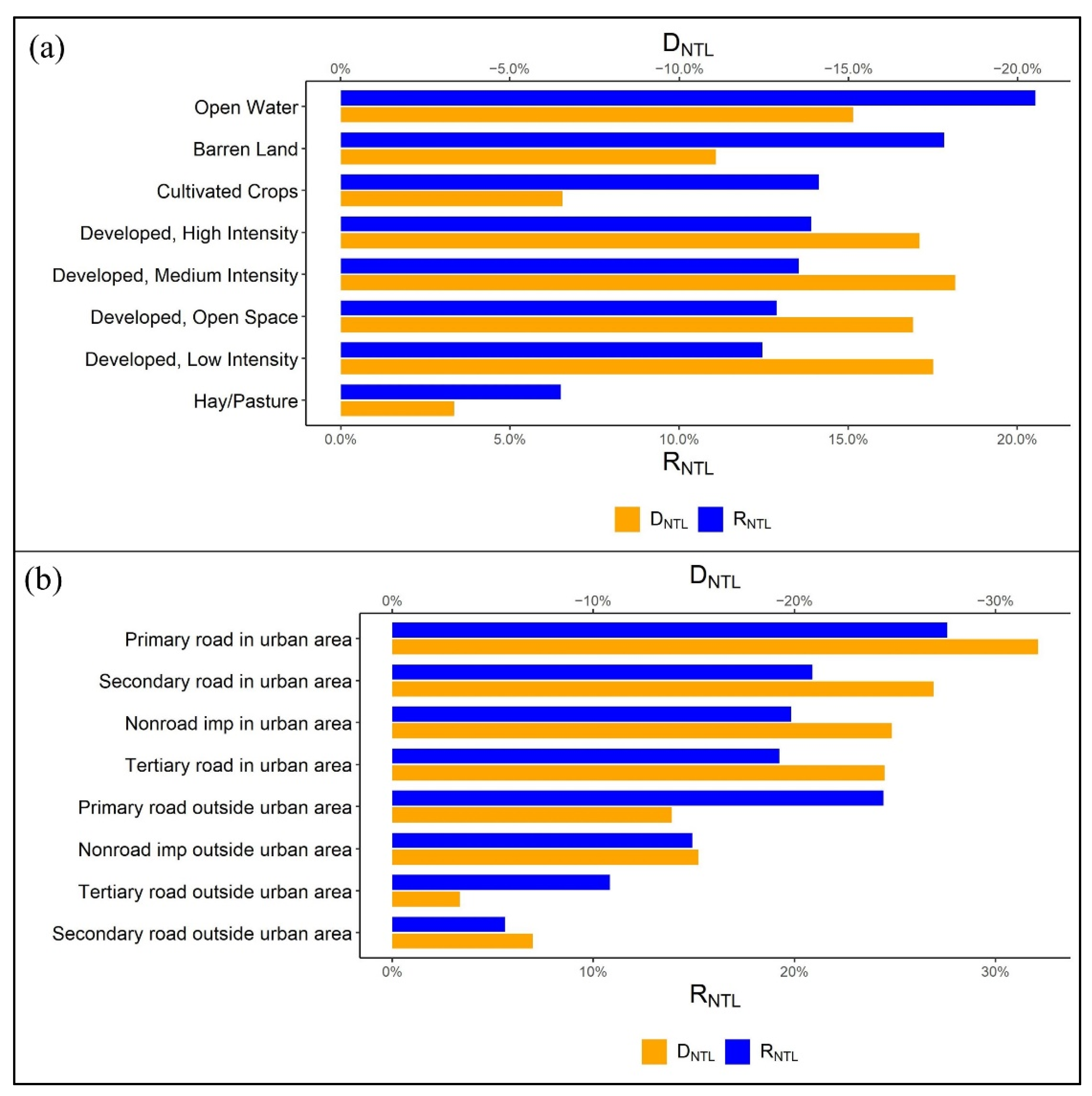
| Variable | Description | Spatial Scale | Data Source |
|---|---|---|---|
| Wind Speed | Recorded maximum surface wind speed from | 1-km buffer | NOAA |
| Housing Damage | Percentage of the non-seasonal damaged housing units | Block group | HUD |
| Tweet Ratio | Ratios of tweets including specific keywords, such as ‘hurricane’, ‘sandy’, etc. | CBSA | Archive.org |
| Distance to Hurricane | Euclidean distance of the place from the hurricane trajectory | Pixel | NWS |
| Land Use & Land Cover | Land Cover and Developed Imperviousness Descriptor | Land-use types | MRLC |
| Independent Variable | Spatial Scale | Sample # | ||||||||
|---|---|---|---|---|---|---|---|---|---|---|
| β | R2 | RMSE | Pr (>|t|) | β | R2 | RMSE | Pr (>|t|) | |||
| Wind speed | −0.012 | 0.241 | 0.198 | 0.000 *** | 0.014 | 0.182 | 0.278 | 0.002 ** | 1-km buffer | 387 |
| Percentage of damaged housing units | −0.001 | 0.006 | 0.23 | 0.019 * | 0.001 | 0.001 | 0.378 | 0.285 | Block group | 909 |
| Tweet ratio (disaster-related to all) | −0.794 | 0.016 | 0.134 | 0.449 | 1.260 | 0.028 | 0.157 | 0.308 | CBSA | 39 |
| Tweet ratio (keyword: close) | 1.519 | 0.002 | 0.134 | 0.794 | 2.762 | 0.004 | 0.159 | 0.689 | CBSA | 39 |
| Tweet ratio (keyword: damage) | −46.617 | 0.171 | 0.123 | 0.009 ** | 38.760 | 0.084 | 0.152 | 0.073 | CBSA | 39 |
| Tweet ratio (keyword: electric) | −86.394 | 0.096 | 0.128 | 0.055 | 135.288 | 0.168 | 0.145 | 0.009 ** | CBSA | 39 |
| Tweet ratio (keyword: evacuate) | −21.121 | 0.041 | 0.132 | 0.215 | 3.744 | 0.001 | 0.159 | 0.854 | CBSA | 39 |
| Tweet ratio (keyword: flood) | −16.233 | 0.043 | 0.132 | 0.205 | 13.727 | 0.022 | 0.157 | 0.368 | CBSA | 39 |
| Tweet ratio (keyword: hurricane) | −3.865 | 0.009 | 0.134 | 0.576 | 12.130 | 0.060 | 0.154 | 0.132 | CBSA | 39 |
| Tweet ratio (keyword: outage) | 4.648 | 0.002 | 0.134 | 0.798 | −28.488 | 0.048 | 0.155 | 0.181 | CBSA | 39 |
| Tweet ratio (keyword: rain) | −10.851 | 0.089 | 0.128 | 0.065 | 8.484 | 0.039 | 0.156 | 0.229 | CBSA | 39 |
| Tweet ratio (keyword: sandy) | −19.519 | 0.157 | 0.124 | 0.012 * | 20.013 | 0.118 | 0.150 | 0.032 * | CBSA | 39 |
| Tweet ratio (keyword: storm) | 1.289 | 0.004 | 0.134 | 0.707 | 2.277 | 0.009 | 0.159 | 0.575 | CBSA | 39 |
| Tweet ratio (keyword: wind) | −16.754 | 0.034 | 0.132 | 0.263 | 24.195 | 0.050 | 0.155 | 0.170 | CBSA | 39 |
| Average sentiment (total tweets) | −0.429 | 0.004 | 0.134 | 0.690 | −0.579 | 0.006 | 0.159 | 0.649 | CBSA | 39 |
| Average sentiment (disaster tweets) | −0.051 | 4.05 × 10−4 | 0.135 | 0.903 | −0.186 | 0.004 | 0.159 | 0.708 | CBSA | 39 |
| Distance to hurricane | 2.32 × 10−7 | 0.001 | 0.777 | 0.000 *** | −3.05 × 10−7 | 0.002 | 0.870 | 0.000 *** | Pixel | 67793 |
| Distance to hurricane | 3.58× 10−7 | 0.156 | 0.124 | 0.013 * | −3.12 × 10−7 | 0.084 | 0.152 | 0.073 | CBSA | 39 |
Publisher’s Note: MDPI stays neutral with regard to jurisdictional claims in published maps and institutional affiliations. |
© 2021 by the authors. Licensee MDPI, Basel, Switzerland. This article is an open access article distributed under the terms and conditions of the Creative Commons Attribution (CC BY) license (https://creativecommons.org/licenses/by/4.0/).
Share and Cite
Xu, J.; Qiang, Y. Spatial Assessment of Community Resilience from 2012 Hurricane Sandy Using Nighttime Light. Remote Sens. 2021, 13, 4128. https://doi.org/10.3390/rs13204128
Xu J, Qiang Y. Spatial Assessment of Community Resilience from 2012 Hurricane Sandy Using Nighttime Light. Remote Sensing. 2021; 13(20):4128. https://doi.org/10.3390/rs13204128
Chicago/Turabian StyleXu, Jinwen, and Yi Qiang. 2021. "Spatial Assessment of Community Resilience from 2012 Hurricane Sandy Using Nighttime Light" Remote Sensing 13, no. 20: 4128. https://doi.org/10.3390/rs13204128
APA StyleXu, J., & Qiang, Y. (2021). Spatial Assessment of Community Resilience from 2012 Hurricane Sandy Using Nighttime Light. Remote Sensing, 13(20), 4128. https://doi.org/10.3390/rs13204128








